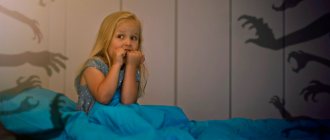Every person is afraid of something and it does not depend on age. Fear is a completely natural and predictable reaction of the body to an irritant that our subconscious sees as a danger. But if we can overcome our fears on our own, it is quite difficult for children to do this. They often themselves do not understand what is happening to them. They just feel extremely uncomfortable. You will not be able to overcome all children's fears, because every child has many of them. But your task is to learn to treat them adequately, work through them and try not to become the cause of fear yourself.
Causes
Numerous studies suggest that most adult fears were formed in childhood. The causes of fear in children include the following factors:
— experienced traumatic situations and fear of their repetition (bee sting, dog bite, fall from a height);
- frequent reminders of the occurrence of expected unpleasant situations;
- accompanying children’s independent actions with an emotionally charged warning about possible danger along the way;
- permanent bans;
- conversations with children about negative events (accidents, murders, deaths, fires);
- family conflicts, the source of which are children;
- disagreements with peers;
- intimidation by parents with non-existent fairy-tale characters (goblin, famously one-eyed, Baba Yaga, merman).
All these fears relate to age-related characteristics and they appear in emotionally sensitive individuals.
Fears in children of preschool and primary school age are manifestations of nervous diseases - neuroses. They are also caused by prerequisites or indirect causes that create the conditions for the emergence of childhood phobias. These include the mother’s incorrect behavior, taking on the role of family leader, which provokes anxiety in the baby. The mother’s desire to go to work early without completing maternity leave also contributes to anxiety, worry, and fear, since there is an acute lack of communication.
The most susceptible to unreasonable fears are children from single-parent families, loved ones and only children who have become the center of their parents’ worries and concerns. The age of the parents plays an important role when fears arise: the older the parents, the more anxious and restless the children are. The appearance of phobias is also influenced by the severe stress or conflict the pregnant mother has previously suffered.
What are children afraid of?
Try talking to your child and find out how many real dangers are bothering him. Prepare cards with the names of fears. Come up with any way to classify them into two categories: “yes” and “no”. For those that cause anxiety in the child, come up with an “execution” in advance.
For example, suggest attaching cards to wooden sticks, some of which can then become the basis of a fire. Another option is to make some kind of good craft out of paper cards, thereby changing the sign of emotions from minus to plus.
"Scary List"
Scientists are constantly calculating what children are most often afraid of.
There are about 30 items on the list. For counting, special forms, questionnaires and diagnostic games are used. And, although it is not so important how many cards you end up with, still do not neglect even those that probably do not apply to your baby. Perhaps during the dialogue it will be possible to find out interesting details. So, the cards should contain fears:
Archaic:
- fire, water, wind and other elements;
- animals (not fairy tales: dog, insect, spider);
- fear of the dark.
Spatial:
- open space;
- cramped rooms;
- depth or height;
- plane, train, bus, cable car and other modes of transport.
Social:
- doctors;
- illness;
- injections and procedures;
- fire;
- attack by a criminal;
- war.
Vital:
- blood;
- pain or discomfort;
- unexpected loud sound;
- death of one's own or parent.
School:
- being late for kindergarten or school;
- punishment for breaking the rules.
Magical:
- fear of being alone;
- certain people;
- fairy tale characters;
- moment of falling asleep (loss of control);
- scary dreams.
If you put together all the information about what scares kids, you get the following interesting statistics :
- 3 years: boys have more fears (9) than girls (7), and at 4 years everything is exactly the opposite;
- from 5 to 7 years old girls are in the lead (12) in relation to preschool boys - 8-9);
- In seven-year-olds, the number of fears decreases: boys – 6, girls – 9.
Of course, these are just average numbers.
But, as we see, children can be afraid of many things. And in most cases, fears are the norm. But anxious children may develop states in which they are afraid of everything. And it is better for a psychologist to work with such children without the presence of parents. This way, the results of diagnosis and correction will be more accurate, and the problem will be overcome faster.
Here's what child psychologist Marina Romanenko thinks about children's fears and methods of dealing with them:
Anxious children
Anxiety tends to increase from the normal level characteristic of the age stage to serious neurotic disorders. Dealing with fear in a highly anxious child may require professional intervention!
A special parental test developed by psychologist A.I. will help determine how much help a child needs. Zakharov. Be as honest with yourself as possible. Don't overthink your answers and try not to make corrections.
| Signs of anxiety in a child | + (the sign is clearly expressed) | 0 (occurs periodically) | – (never encountered) |
| He takes everything too personally, often gets upset, and worries a lot about everything in the world. | |||
| Cries bitterly for any reason, and also often whines, grumbles, and takes a long time to calm down. | |||
| He becomes frighteningly often irritated over trivial matters and is capricious. Cannot tolerate or wait. | |||
| He gets offended, can’t stand comments, and immediately sulks. | |||
| Unstable in mood, he can even laugh and cry at the same time. | |||
| Sad for no apparent reason, does not talk about the reasons. | |||
| Sucking a finger, a pacifier, constantly twirling some object in his hands. | |||
| Without light it is very difficult to fall asleep. Toss and turn for a long time, restless sleep. It's hard to come to your senses in the morning. | |||
| He gets excited when he needs to be calm, and gets into a stupor when he needs to complete a task. | |||
| In unknown situations, in the presence of new people, in new places, expresses excessive anxiety. | |||
| Indecisive, unsure of himself and his actions. This symptom is growing. | |||
| Gets tired easily, is often distracted, has difficulty concentrating, and these symptoms get worse over time. | |||
| It is becoming increasingly difficult to find a common language with a child; he often withdraws from dialogue. Changes decisions. | |||
| He began to complain more often of headaches and abdominal discomfort. Turns red, turns pale, itches, and sweats. | |||
| Shows poor appetite, which is increasingly decreasing. Sick for a long time, the temperature may rise for no reason. Often misses school or kindergarten. |
Pluses weigh 2 points, zeros - 1. To evaluate the results, count the points. A normal indicator of the level of anxiety, taking into account age-related characteristics, is considered to be less than 5 points!
If you get 5–9 points, you need to pay attention to the baby. Talk, observe and think: perhaps he is just shy. If the score is from 10 to 15, the nervous disorder already exists, but has not yet reached the stage of disease, you can overcome it on your own.
You should start fighting and looking for what to do if the child is afraid of everything when the total points reach 15–20. These are the first signs of creeping neurosis.
Parents who are faced with a serious problem of childhood neurosis score 20–30 points; you should definitely consult a doctor!
Demonstration of fear
Sometimes the external picture of behavior is very similar to horror, but the person does not actually experience it. The reason for this is character, its bright features, complexes, and peculiarities. Most often this is a demonstrative type of character, and one often observes it in spoiled children who are allowed vivid expression. Weaning them off fear can be more difficult than getting rid of true fear.
To distinguish real cowardice from acting tricks aimed at attracting attention, pay attention to physiological signs, and also entrust the conversation about horror stories to a neutral family member who is not affected by the tricks. Physiological signs of strong fear will help to distinguish it from the habit of being shy, and from demonstrations, and from protests: dilated pupils, trembling of hands and body, loss of orientation in space, stuttering or loss of the ability to speak, crying.
The fearful person may flinch, blink frequently, lose balance or sometimes consciousness, try to run away, refuse dialogue, lose control of himself and even fight. If the fear is so strong, it is advisable to consult a child psychotherapist.
Fears in preschool children
Children in preschool age often come up with the subject of fear on their own. Many in childhood were afraid of the dark, where ordinary objects easily became menacing monsters in the imagination, but not everyone carried these phobias into adulthood, since all children react differently to their own fantasies. Some quickly forget about them, while others develop nervous disorders.
Fears in preschool children are often provoked by adults who meaningfully warned them in advance about the danger. Parents, educators, grandmothers sometimes remind the child too emotionally of the consequences of a situation or any action, which provokes the emergence of fears. Menacingly spoken phrases: “Don’t touch - you’ll get burned!”, or “Don’t climb - you’ll fall!” - become a source of fear for children. Children involuntarily remember the second part of what is said in a sentence, and constantly feel anxious. The fear reaction can take hold and further spread to all typical similar situations.
The fears of young children can be triggered by a situation or a specific incident that happened, for example, in a store, on the street. The fear of repeating an unpleasant incident is often easy to correct. It all depends on the child’s temperament and his individual traits: anxiety, suspiciousness, uncertainty. The environment plays an important role in the emergence of fears in preschool children. Conflicts in the family: quarrels between parents make the child feel guilty about what happened.
What to do if a child has fear? Fears in preschool children need correction, since fear instilled in childhood can haunt a person throughout his life.
Fears in children of primary school age
One of the reasons for fear of primary school age is the difficulty of communicating with peers in a group. If difficulties arise in a team where the child is offended, he may refuse to attend school, a club, or will show nervousness, tearfulness, uncertainty, and panic. This often happens due to intimidation from older peers. In this situation, it is necessary to deal with it together with teachers and a psychologist and not delay the resolution of the conflict.
Fears in children of primary school age may arise due to mental disorders. For example, fears may be a symptom of neurosis that requires mandatory treatment. Neurosis can manifest itself through fears that are not typical for this age, and can also be caused by severe attacks of phobias for various reasons.
Psychosomatic disorders originating from childhood
Parents often do not understand the enormous impact words have on a child. Critical judgments addressed to your child can lead to low self-esteem, lack of self-acceptance and difficulties in relationships in society. Even the emotionally stable can suffer from constant criticism. Criticism should be constructive and should not put pressure on the developing psyche of the child. We must not forget that the inner world is formed under the constant influence of the external world and the behavior of the individual in the future depends on this.
Russian psychologist Lev Vygotsky said quite well that respect for a child's personality by parents allows him to grow up with self-respect with unsuppressed self-esteem and his reactions are healthy. If, however, the parent is demanding through measures, neglecting individuality, then self-esteem becomes low and indifference to oneself prevails. This attitude is taken for granted, which the child is powerless to change. Hence the need to change yourself, which deforms the personality.
Fears in children 5 years old
In first place among the reasons causing fear in children aged 5 years is unfavorable relationships with parents, especially with the mother.
Fears in 5-year-old children are also caused by the peculiarities of interaction between the child and the teacher: inconsistency of assessments and requirements, the predominance of authoritarian communication. In both cases, children are in a state of tension and constraint due to the fear of not fulfilling the demands of adults, as well as the fear of crossing strict boundaries. All disciplinary measures taken by such teachers often come down to shouting, reprimanding, negative evaluations, punishments, and prohibitions.
An inconsistent teacher provokes fear by the inability to predict the child’s own behavior. Constant changes in the teacher's demands, emotional lability and the direct dependence of behavior on his mood lead to confusion in children and do not make it possible to understand what the right thing to do is.
In 5-year-old children with different levels of imagination development, differences in fears are noted: with a low level of imagination, fears of a realistic nature predominate; with a high level of imagination, fantasy fears predominate.
The important role of the psychologist in helping the child and parents
You shouldn’t think that it will outgrow... Children’s fears are rarely forgotten; they follow us into adulthood and then become the causes of phobias, panic, and more. If the baby is not helped to cope with his conditions, he will experience severe psychological stress. And it, in turn, affects physical and mental development.
Parents cannot always help their children on their own. After all, it’s not enough to just talk or calm down. Therefore, their assistant becomes a children's psychological center, where professional psychologists, using special techniques, will help the child cope with fear, understand the cause and get rid of obsessive states. The main methods used are drawing, fairy tale therapy and games. But it is important to remember that working with a baby is built separately in each case.
Only with the help of parents and a child psychologist will the child be able to overcome his fears and stop being afraid.
Night terrors
Partial awakening of the baby at night, which is expressed in screaming, panic, tears, walking around the room, throwing around the crib, muttering, is classified as night terrors. This behavior is usually observed during the first 2 hours of sleep. These episodes are harmless and often end in deep sleep. They are considered part of natural maturation up to 6 years of age.
Night fears in children are marked by the following symptoms: the baby is scared, it is impossible to wake him up, calm him down, his eyes are wide open, but he does not see anyone nearby, all objects, as well as people in the room, appear frightening; a nighttime episode of fear usually lasts 10 - 30 minutes; upon awakening, the baby does not remember anything that happened to him.
Reasons for real fears and how to respond to them
Let's take a closer look at the main childhood fears in children from 4 to 6 years old and try to figure out what adults need to do about it. Provided a competent approach and adequate support from parents, in the absence of conflicts in the family, children's fear is overcome quite quickly.
Fear of animals and insects
For some children, the fear of insects or animals is relevant.
What to do?
In such cases, it is recommended to change the baby’s emotional state - from frightening to interested. For example, go out into the field with him, find a spider there, and put it on your palm. After this, you should explain to your child that the spider is completely open in front of you, is not up to anything and, on the contrary, is more vulnerable than people.
Telling interesting stories about animals and insects that your baby is afraid of can arouse curiosity on his part. The more the baby knows about the subject of his fear, the faster he will get rid of fear.
In the case of a dog, you also need to create a favorable background around the animal. Never yell at your child or intimidate him because the dog might bite or infect him with something. Explain to your child that it is forbidden to pet a dog without the owner’s permission and that it is better to establish first contacts with the animal from a distance so as not to scare it away.
Look through books and encyclopedias about animals, visit exhibitions, and demonstrate how to safely interact with insects and animals by your own example.
Fear of white coats
This fear is closely related to the fear of pain. An injection given by a person in a medical cap and a white coat, or an examination with unpleasant instruments leaves a child with an association with unpleasant sensations for a long time. Children begin to be terrified of doctors, and this fear is much stronger and more dangerous than the pain itself caused by the procedure.
What to do?
To reduce the fear of people in white coats, a few days before going to the clinic, tell your child about the doctor’s work. Play doctor with him, using as many special medical instruments as possible: listen to him, examine the oral cavity, and perform other possible manipulations. Be sure to switch roles with him.
When communicating with the doctor and nurse from the treatment room, be courteous and polite, watch your emotions: smile kindly, behave at ease - the child should see your calmness and confidence that nothing threatens him.
If you visited the dentist or vaccination office, do not forget to praise your baby for his patience and courage, even if his condition was the opposite. After leaving the clinic, try to immediately switch the baby’s attention to other objects: tell him an interesting story, a fairy tale.
Fear of loud noises
One of the innate fears of humans is the fear of sharp sounds. Nature is designed in such a way that a loud sound is a symbol of danger. In addition, loud sounds contribute to overstrain of brain cells and lead to disruption in the functioning of some organs. Therefore, the instinct of self-preservation makes the child flinch at sharp shouts, roar, or grinding of machines.
What to do?
If your baby suddenly bursts into tears due to thunder or other sudden noise, you should stand next to him, hug him and let him know that you can protect him, he is safe next to you. Do not laugh at him, do not shame him, otherwise he will begin to hide his fear from you, but he is unlikely to be able to cope with it on his own.
It is best to start games with different sounds: from quiet to loud. A metallophone and ringing metal spoons are suitable for practicing. Go together to a noisy children's party or a fun attraction where everyone squeals, screams and jumps. The joyful noise will gradually accustom the baby to loud sounds.
Fear of strangers
Fear of strangers arises in infancy and has quite obvious roots. It is formed at the physiological level - the baby subconsciously begins to sense danger in a stranger. At the same time, he withdraws, lowers his head and hides behind a loved one.
If parents behave correctly, fear usually goes away by the age of three or four. But, if socialization at this age has not begun, it is worth paying special attention to the problem. Otherwise, the situation threatens to lower the child’s self-esteem and negatively affect further communication with peers.
What to do?
Since fear in this case goes hand in hand with shyness, parents need to take the first steps themselves. For example, approach children on the playground with your child who are already communicating with each other. Talk to them, introduce them to your child. You should visit children's centers and developmental classes more often, and visit friends who have children of the same age.
If the baby is afraid to be alone with another adult, for example, with a nanny, you need to take a little more time to get to know each other. In order for the child to get used to strangers, the three of them need to spend some time together. As soon as the baby begins to trust the new person, contact him first, you can safely leave them alone.
Fear of loneliness
The fear of being left without a mother for a long time is considered a common fear among children. In no case should he be mistaken for spoiled behavior or unreasonable whims. The fear of losing your mother is quite natural and requires a delicate approach.
What to do?
Always explain to your child when you will be back. For example: - “After you sleep and eat your afternoon snack.” It is recommended to make such approvals regular. In this case, you should not only negotiate kindly with the baby, but also fulfill your promises in a timely manner.
Fear of the dark and nightmares
One of the important childhood fears is the fear of the dark. The baby’s imagination develops rapidly, giving him monsters, scary characters from cartoons, fairy tales, books, hidden in the closet or under the bed.
What to do?
The main condition for combating the fear of the dark and fictional characters is a calm psychological atmosphere in the house. Under no circumstances should you scold a child for being afraid or throw indifferent phrases like this: “There’s nothing scary there.”
Reassure your child that he is completely safe. To do this, leave the door to his room open, buy a funny children's night light.
Offer to draw or sculpt someone he is afraid of, then give the hero a comic look and laugh at him together.
Come up with an interesting fairy tale with a scary character from a child's imagination, ending it positively. Your hero should gradually turn into a good friend and assistant.
Make it a rule before going to bed to calmly talk with your child in his room, read books, listen to calm music together. Physical contact and gentle words are appropriate.
Claustrophobia
The fear of the dark has something in common with the fear of enclosed spaces. The child may not voice the problem and the parents notice it themselves, closing the door to his room in the evening, or getting stuck in the elevator with him. Frequent manifestations of claustrophobia are accompanied by panic attacks and dizziness. Children can run to their parents in the middle of the night and start crying.
This obsessive fear occurs more often in the only child in the family who has limitations in communicating with peers. It especially affects children who receive excessive amounts of affection and love.
What to do?
First of all, the child in such a situation should be calmed down and taught to breathe evenly. Scolding someone for what you think is an unmotivated fear is strictly prohibited. You can’t do the opposite and lock him in the room.
Games aimed at overcoming the stiffness that arises in a confined space can be effective. For example, a specialist in the field of child psyche A.I. Zakharov offers the psychological game “Penetration and exit from the circle.”
The essence of the game is that adults and children stand in a circle, clasp their hands and close their eyes. At the same time, they declare out loud that no one will be able to penetrate their circle - they carefully guard it and there is no place for any daredevils there. This phrase itself subconsciously incites the child to fall into the circle. Players walk outside the circle and try to slip unnoticed under one of the pairs of hands. The one who slipped into the middle loudly claps his hands and everyone opens their eyes in surprise. The second part of the game involves the same way out of the circle.
Fear of punishment
Even the most harmless punishment of a child can lead to unexpected consequences. Thanks to measures to lock a naughty baby in a dark room, closet or other place with little light, he may develop several fears at once: fear of confined spaces, darkness, loneliness, the appearance of nightmares in his sleep.
In addition, such punishments break the child’s psychological connection with adults; he feels alienated by his parents, which in the future can lead to problems in marriage for an adult.
What to do?
It is worth remembering that any mistake of a child is, first of all, a parental omission in upbringing. And that means you need to punish yourself, not him. Any reproach should always be expressed in the form of love for the baby. Otherwise, he will begin to associate the evil mother with Baba Yaga from a fairy tale, and his father with the Serpent Gorynych, which will give rise, in addition to the above fears, also fantasy ones. You can read more about this type of fear in the article “Fear of fairy-tale heroes and fictional characters.”
Treatment of nightmares
Help your baby return to normal sleep without trying to wake him as he sleeps soundly during a night terror episode. Dim the lights in the room, talk to the baby in a soothing, calm voice. Take him in your arms, do not scream or shake him, as this will only make the situation worse.
Take all measures to prevent all kinds of damage, since during the period of night terrors the baby may get out of the crib and run or go somewhere. The baby must be very gently returned back to his crib. It is very important to prevent the occurrence of night terrors than to deal with them later.
The likelihood of developing night terrors is higher if the baby is overtired. Make sure that your child adheres to a daily routine and is sure to sleep during the day. Keep track of the time frame in which night terrors appear. During the week, try to wake up 15 minutes before your expected night terrors, trying to keep you from falling asleep for up to 5 minutes.
If night terrors still recur, then repeat these steps for another week. Be sure to seek help from specialists if episodes of night fears last more than 30 minutes, if episodes are observed in the second half of the night, if the baby is very restless and says something incoherently, if the baby does something dangerous for his life, if daytime fears are noted , and also if the cause of night fears is a stressful situation.
Nightmares are scary dreams that cause the baby to wake up and be afraid to go back to sleep. Scary dreams are normal for all ages after 6 months. They are often determined by the child's developmental stages. Children 2-3 years old dream that they are alone, children 4-6 years old dream about monsters, as well as darkness, and the nightmares themselves often occur during the third phase of sleep. There is no specific reason for the occurrence of nightmares, but sometimes terrible dreams are provoked by what the baby heard or saw, and this greatly upset him.
Nightmares in children are treated with good fairy tales with a good ending; soft, favorite toy; games with a flashlight, eliminating night fears; games that imitate the actions of animals (the mouse hides under the blanket); drawings depicting fear - the monster and its destruction; with the exception of watching scary movies and cartoons, with the door open to the baby’s bedroom. Help your baby tell you about his nightly dream, and he will definitely feel better. Never scare him with fairy-tale characters. If your nightmares become more frequent, be sure to consult a doctor.
Children's panic fears
The development of panic fear occurs spontaneously, but in the future this state is often associated with specific situations or environments. Often, panic fears arise against a background of misunderstanding and ridicule when children are at school. This manifests itself in isolation and inability to establish contacts with classmates. Worsened relationships with others significantly influence the decline in academic performance. If concern is detected, it is necessary to talk and find out the reason, since the condition may worsen if the child tries hard to hide his condition or hide his emotions.
Panic fears in children are accompanied by various vegetative symptoms and are caused by stress or provoking factors. This condition is marked by vulnerability, insecurity, and muscle tension, so the support of parents and loved ones is important. To relieve such symptoms, psychologists advise choosing an interesting hobby and staying nearby as much as possible. Panic fears in children may be caused by the presence of other anxiety disorders (imminent separation from loved ones, etc.).
Sometimes children pay for their parents' fears
It's no secret that there is a strong emotional connection between parents and children, especially between mother and child. Since suggestions practically do not work until the age of six, the influence can be made through the mother, which will trigger the child’s somatics.
One day a woman approached me. During pregnancy, she had a problem with the co-owner of the business. Constant conflicts subsequently affected the child after childbirth. The daughter suffered from a strange form of dermatitis. If the mother began to get nervous, the child would suffer from eczema.
The Skype sessions did the trick. Emotional triggers were removed, which stopped a number of negative reactions, pity, resentment and outbursts of anger. Within three sessions the problem was completely resolved. The daughter’s rashes stopped, against the backdrop of strengthened emotional stability in the mother.
Fear of the dark
Often, the fear of the dark is provoked by parents themselves, adults or someone else, when they jump out of the darkness and scream in a scary voice or talk about ghosts in the dark.
The fear of the dark in children is eliminated by a kind of “hardening” with darkness, when they gradually increase the time spent in a dark room or sit with a flashlight, showing and explaining that there is nothing in the room except objects. But it’s definitely better to turn on the light for the baby, and let him calmly see that nothing in the room has changed and wait until he grows up.
The most reasonable way to quickly rid a child of the fear of the dark is to always leave the light on, since in the dark he feels defenseless and feels danger around him due to lack of vision. And the wild imagination threateningly draws in evil spirits and night monsters. A switched-on night light will not be able to remove the mechanisms that provoke the fear of the dark; it will only push the problem aside. There is a possibility that over time the baby will acquire new phobias and will sleep in the light all his life. Most likely, your baby is still afraid to be left alone at home, perceiving it as a threat to his life.
How to help a child overcome fears? Nurture in your child the ability to sympathize, have compassion, and empathize. This will help push out the fear so that it will no longer bother you.
Fear of death
This phobia has an adverse effect on the child’s psyche, so refrain from phrases like: “If you don’t listen, I’ll get sick and die.” Prevent children from attending funerals until they are 10 years old if possible. But when talking, periodically mention deceased relatives, this way you will understand that after death a person lives in the hearts of people. Thoughts about death are noted at the core of most childhood phobias. These fears are manifested either openly by statements about the fear of dying, or hidden - in the form of a fear of getting sick, fear of heights, sharp objects, darkness, loneliness, and so on.
The fear of the death of parents is the fear of being deprived of parental support, love, and care. Somatic diseases that threaten or weaken the health of children with phobias only aggravate the neurotic state, especially when there is a danger to health and life. Adolescents have obsessive fears of contracting a fatal disease, fears of the death of loved ones, fear of choking while eating, etc.
Fear of water
There are often two types of fears of water. The first is the fear of washing in the shower or bath. This fear arises from the beginning of learning to bathe every day, but it happens that a baby who had been bathing happily before suddenly stops loving this activity: he cries when the need to take a bath is mentioned. Children have the hardest time washing their hair (four out of five children do not like this procedure).
The second type of fear of water is fear of bodies of water (lakes, sea, wide river). Kids can get confused by the abundance of sand and water, big waves, as well as a large number of people, the squealing and noise of children. For kids, this can serve as an alarm signal.
Young children's fear of water gradually disappears as they grow older. Children are often afraid not of drowning, but of certain properties of water (waves, current strength, temperature).
How to overcome your fear of water? It is important for parents to figure out what exactly the baby is afraid of, at the same time restrain their irritation, be patient and not use offensive words in front of the child (slob, coward, dirty). Do not try to forcefully dip your baby into the river, or deliberately force him to stand in the shower, as this will only aggravate the situation and deepen fear. You definitely should not give up washing your hair, as well as other hygiene procedures, but this must be done with minimal trauma. To do this, maintain a comfortable temperature regime (water temperature 37-40 degrees), a good “tearless” shampoo. For bathing, let the child select toys himself, offer splash toys, let him buy a doll, wash her hair, wash toy cars. Invite your child to water the flowers. Such simple actions will help children get comfortable and gradually get used to the water, without being afraid of it.










